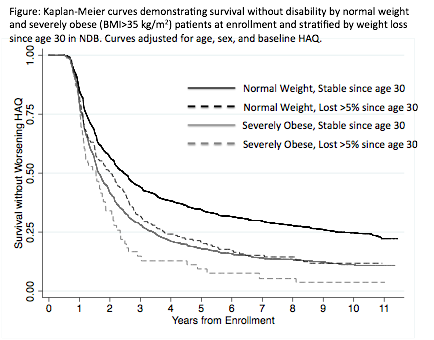Session Information
Date: Tuesday, November 7, 2017
Title: Rheumatoid Arthritis – Clinical Aspects Poster III: Comorbidities
Session Type: ACR Poster Session C
Session Time: 9:00AM-11:00AM
Background/Purpose:
Obese patients with rheumatoid arthritis (RA) have greater disability in cross-sectional studies. There are no long-term studies that assess trajectories of disability among individuals in different body mass index (BMI) categories. We evaluated associations between obesity, weight loss, and incident disability in two large longitudinal registries.
Methods:
This study included patients with RA and available data from the National Data Bank of Rheumatic Diseases (NDB) (N=22,432) and the Veterans Affairs RA (VARA) registry study (N=1580). Incident disability was defined as an increase of >0.2 on the Health Assessment Questionnaire (HAQ or MD-HAQ) (based on the MCID). Disability scores and BMI were recorded at routine clinical visits (VARA) or by questionnaire every 6 months (NDB). Patents from NDB were asked to estimate their weight at age 30. Multivariable Cox proportional hazards models evaluated associations between BMI and weight change and the risk of incident disability.
Results:
Disability was greater at enrollment in severely obese (BMI >35 kg/m2) patients compared to normal weight (BMI 18.5-25 kg/m2) after adjustment for demographics in NDB [B: 0.31 (0.28,0.34) p<0.001] and VARA [B: 0.19 (0.085,0.30) p<0.001]. Disability increased annually in both NDB [B: 0.011 (0.01, 0.012), p<0.001] and VARA [B: 0.022 (0.018, 0.027) p<0.001]. In multivariable models, severe obesity and greater comorbidity were associated with incident disability (Table). Associations for obesity were independent of disease duration, comorbidity, and time-varying CRP and swollen joint count (in VARA). In NDB, 5% weight loss from age 30 to enrollment (9.7% of patients) was associated with a greater risk of incident disability in similar models [HR: 1.13 (1.04,1.23) p=0.004] (Figure). Similarly in VARA, 5% weight loss from enrollment as a time-varying predictor (22.8% of observations) was associated with incident disability independent of time-varying BMI [HR 1.40 (1.15,1.71) p=0.004]. Figure 1 shows that survival without incident disability was shorter among severely obese patients in NDB and among those who lost 5% of weight since age 30.
Conclusion:
Obesity and comorbidity at enrollment predict greater and worsening disability scores in RA- an effect that is independent of disease activity. A direct effect of excess weight on disability over time represents an important confounder of these measures as RA outcomes. Interestingly, prior weight loss also predicts disability, possibly by identifying chronically ill individuals with unintentional weight loss.
|
Table: Cox proportional hazards models evaluating the risk of incident disability (HAQ or MD-HAQ increase >0.2). |
||||
|
NDB (HAQ)
|
VARA (MD-HAQ)
|
|||
|
|
HR (95% CI)
|
p
|
HR (95% CI)
|
p
|
|
Model 1
|
N=22,432
|
|
N=1,580
|
|
|
Enrollment BMI |
|
|||
|
<18.5 kg/m2
|
0.91 (0.79, 1.06) |
0.22 |
0.94 (0.55, 1.59) |
0.82 |
|
18.5-25 kg/m2
|
(reference)
|
— |
1 (reference) |
— |
|
25-30 kg/m2
|
1.08 (1.03, 1.14) |
<0.001 |
0.93 (0.79, 1.11) |
0.46 |
|
30-35 kg/m2
|
1.23 (1.17, 1.31) |
<0.001 |
1.04 (0.86, 1.26) |
0.62 |
|
>35 kg/m2
|
1.36 (1.28, 1.45) |
<0.001 |
1.27 (1.00, 1.60) |
0.05 |
|
Baseline HAQ/MD-HAQ |
0.52 (0.51, 0.54) |
<0.001 |
0.51 (0.46, 0.58) |
<0.001 |
|
Follow-up Time (per yr)
|
1.11 (1.09, 1.13) |
<0.001 |
1.36 (1.21, 1.53) |
<0.001 |
|
Age (per 10 yrs)
|
1.00 (0.98, 1.01) |
0.80 |
1.03 (0.96, 1.11) |
0.34 |
|
Male |
0.66 (0.63, 0.69) |
<0.001 |
0.98 (0.77, 1.24) |
0.87 |
|
Caucasian |
0.87 (0.80, 0.94) |
<0.001 |
0.84 (0.72, 0.98) |
0.02 |
|
Comorbidity Score* |
1.10 (1.09, 1.11) |
<0.001 |
1.06 (1.01, 1.11) |
0.02 |
|
Disease Duration (per yr)
|
1.03 (1.02, 1.05) |
<0.001 |
1.00 (0.94, 1.06) |
0.93 |
|
Current Smoking |
1.13 (1.04, 1.22) |
0.003 |
0.99 (0.84, 1.20) |
0.94 |
|
Time-varying factors |
||||
|
Swollen Joints
|
— |
— |
1.05 (1.04, 1.06) |
<0.001 |
|
CRP (per mg/dL)
|
— |
— |
1.04 (1.02, 1.07) |
<0.001 |
|
*The comorbidity score is the Rheumatic Disease Comorbidity Index, range 0-9. Abbreviations: VARA- VA Rheumatoid Arthritis; PY= Person-Years; HR= Hazard Ratio; HAQ= Health Assessment Questionnaire; MD-HAQ= Multidimensional Health Assessment Questionnaire; BMI= Body Mass Index; CRP= C-Reactive Protein |
||||
To cite this abstract in AMA style:
Baker J, Mikuls TR, England BR, George MD, Cannon G, Sayles H, Sauer B, Caplan L, Michaud K. Impact of Body Mass Index and Weight Loss on Incident Disability in Patients with Rheumatoid Arthritis [abstract]. Arthritis Rheumatol. 2017; 69 (suppl 10). https://acrabstracts.org/abstract/impact-of-body-mass-index-and-weight-loss-on-incident-disability-in-patients-with-rheumatoid-arthritis/. Accessed .« Back to 2017 ACR/ARHP Annual Meeting
ACR Meeting Abstracts - https://acrabstracts.org/abstract/impact-of-body-mass-index-and-weight-loss-on-incident-disability-in-patients-with-rheumatoid-arthritis/

